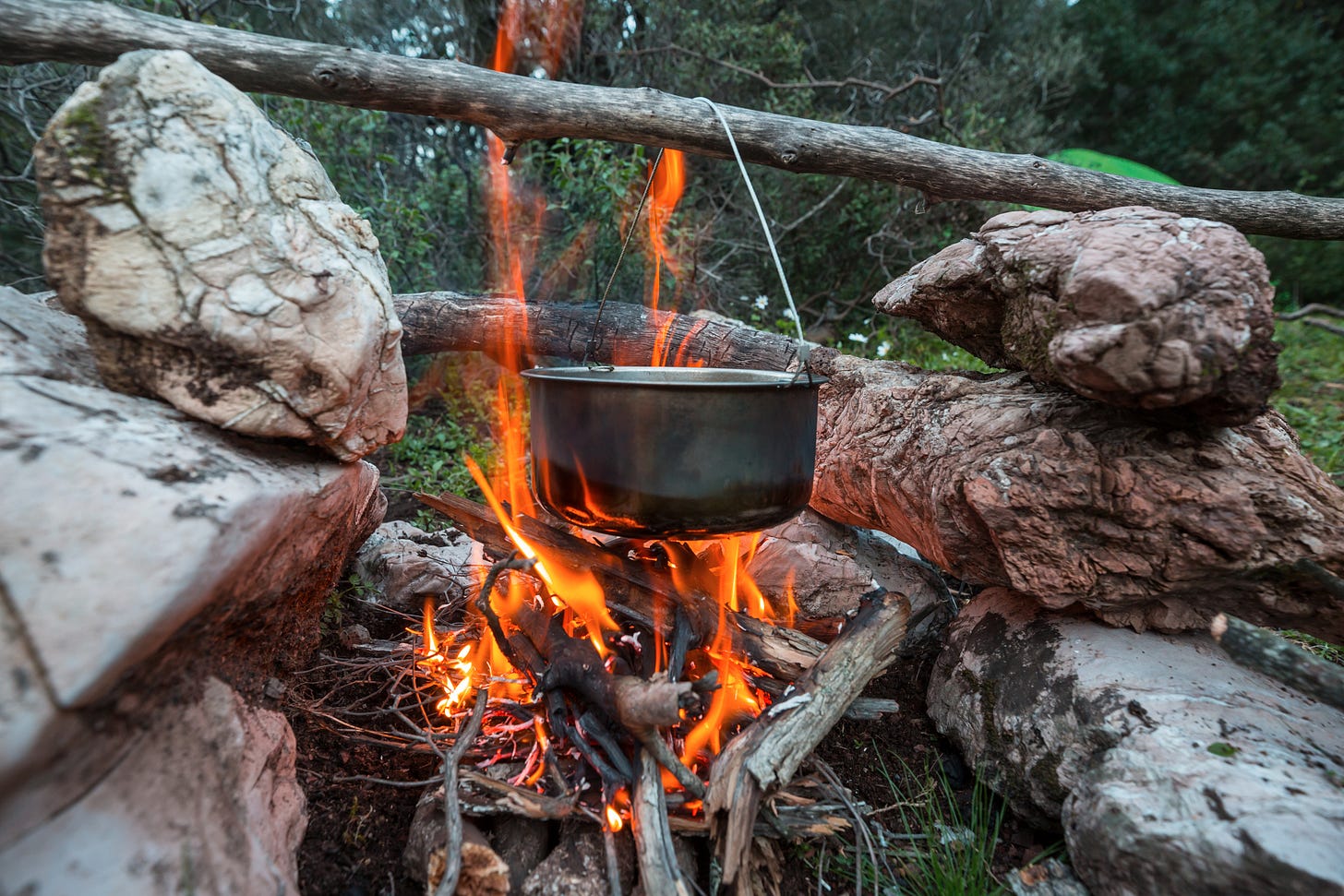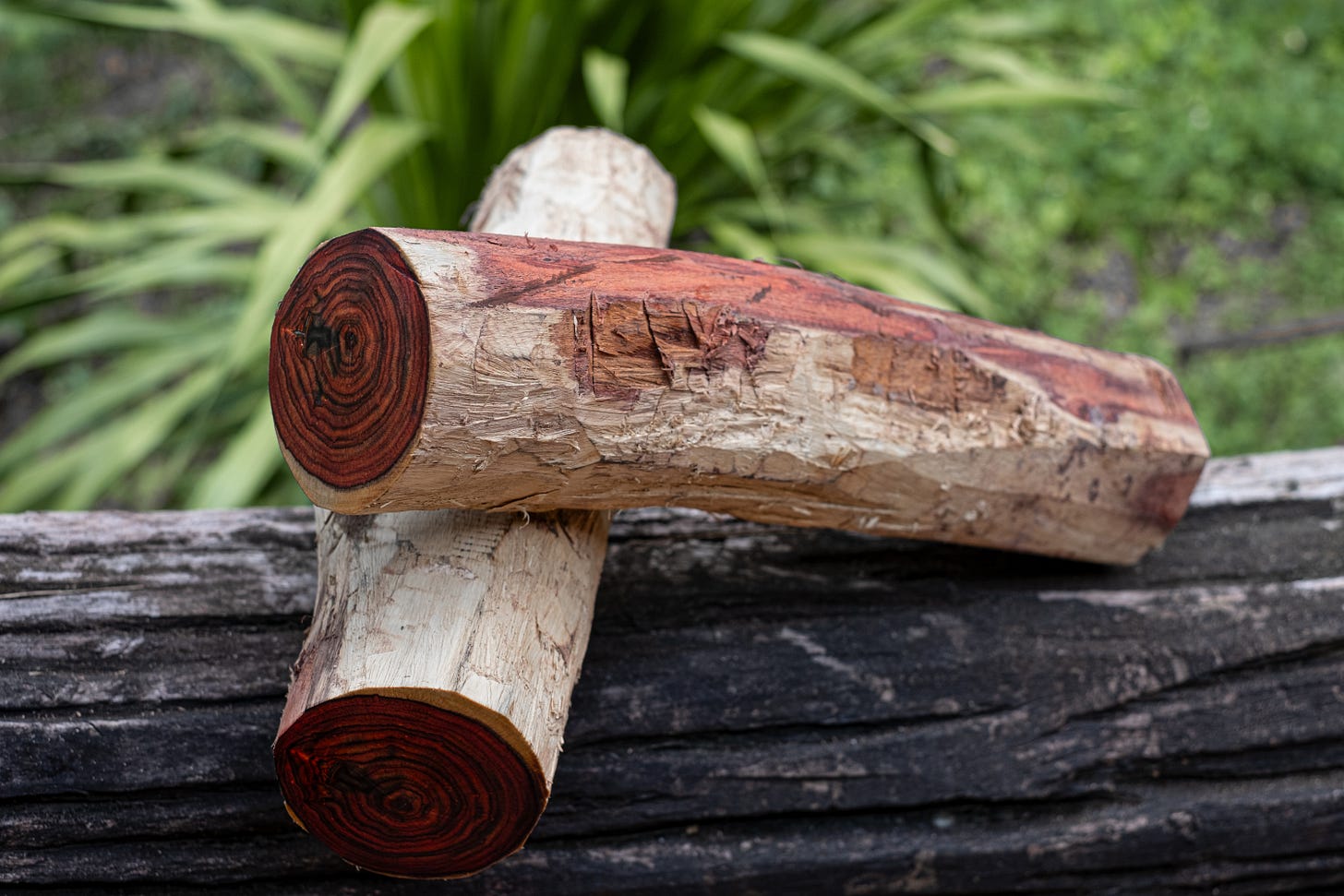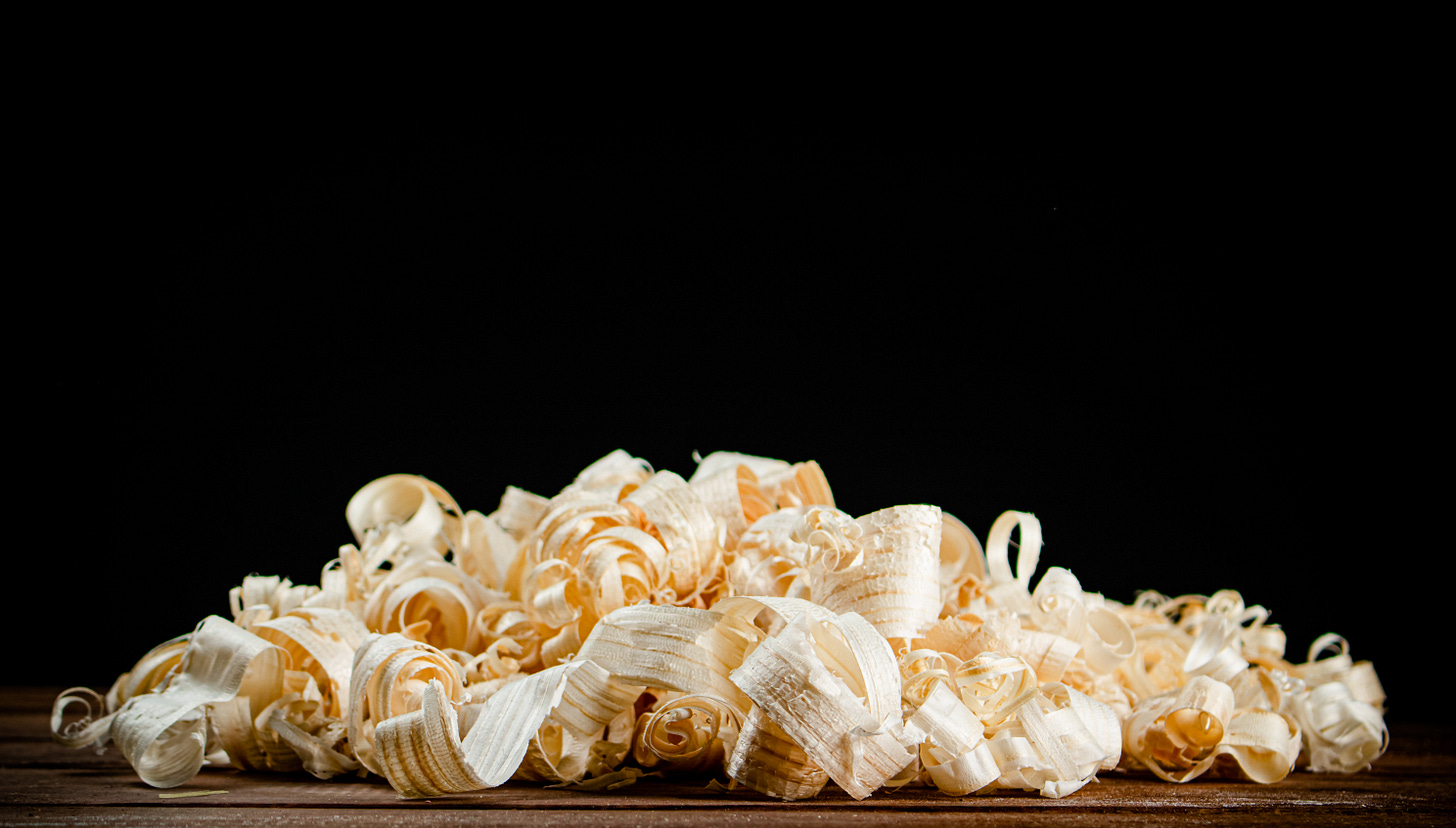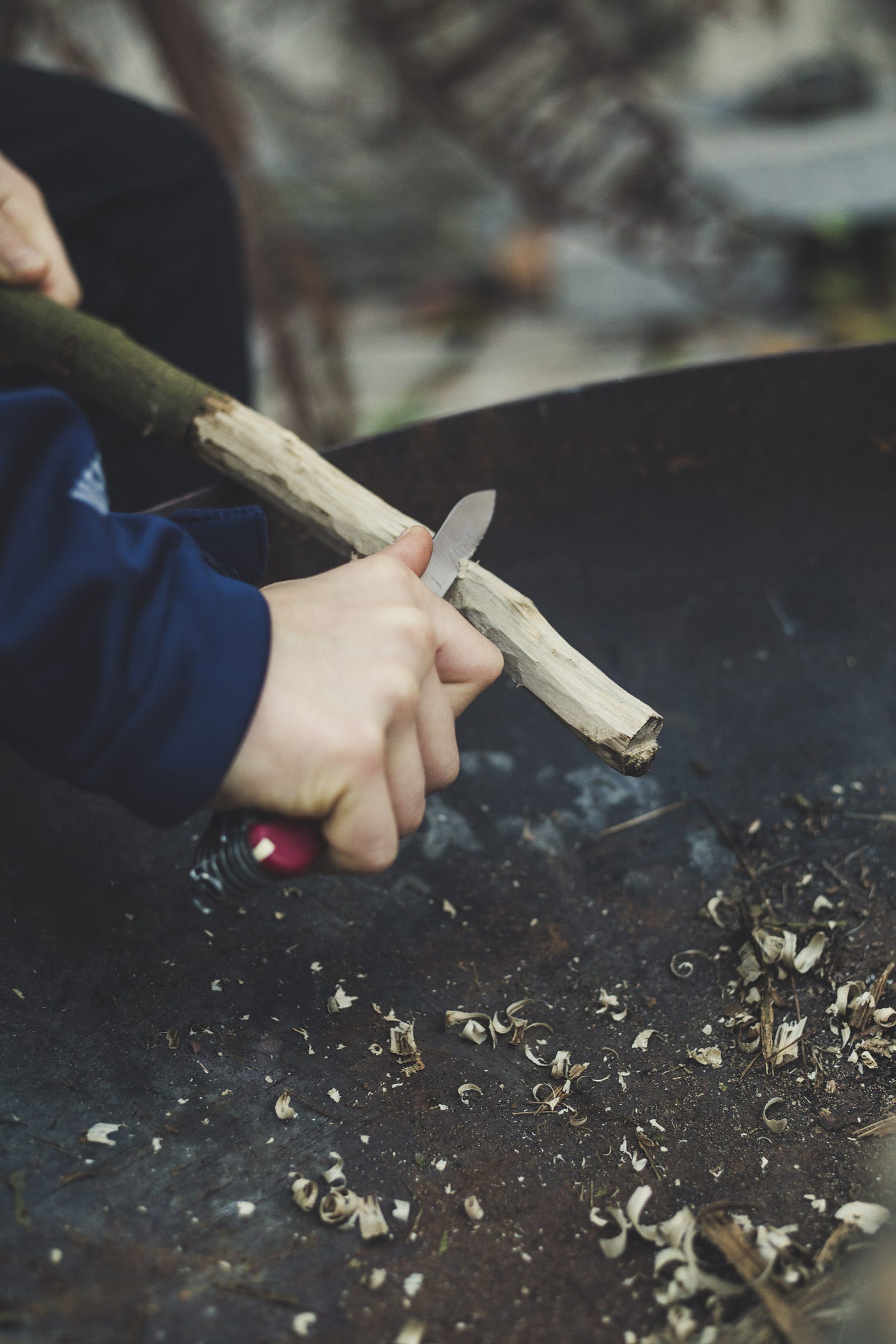Firecraft is a cornerstone skill set of the Collapse Curriculum. Fire has been humanity's trusted ally for millennia. Whether you're deep in the wilderness on a recreational hike, faced with a sudden emergency in the backcountry, or preparing for societal collapse, the ability to start and sustain a fire remains an indispensable skill. It is the cornerstone of survival, offering not only warmth and light but also psychological reassurance in challenging circumstances.
Contextual Basis for Fire
For outdoor recreation, fire transforms a cold, damp campsite into a warm and inviting haven. It cooks our meals, purifies our water, and wards off insects and predators. Beyond its practical uses, fire kindles a sense of connection to the natural world, a reminder of simpler times when the flames provided more than heat—they brought a community together under the stars.
In emergency preparedness, fire is equally critical. Unexpected survival situations can arise in the wilderness, during natural disasters, or even in urban settings where power and utilities fail. In such scenarios, fire becomes a lifeline: a means to stay warm, dry clothes, cook food, signal for help, and disinfect water. For those who venture outdoors or seek readiness for unpredictable events, the knowledge of firecraft is a skill that bridges the gap between vulnerability and resilience.
As we consider preparation for societal collapse—whether due to environmental crises, economic downturns, or infrastructure failures—the importance of firecraft cannot be overstated. Fire enables independence from fragile systems, empowering individuals to secure heat, cook food, and maintain hygiene even in the harshest conditions. It is a tool of both survival and self-reliance, fostering resourcefulness and adaptability in the face of uncertainty.
Mastering the art of firecraft is not merely a skill; it is an empowering act that connects us to our primal roots and prepares us for the unknown. To start a fire is to ignite more than kindling—it sparks warmth, safety, and a sense of control, no matter where the trail of life leads.
F.I.R.E: The Four Pillars of Firecraft
To simplify understanding fire and the resources skills and order of operations required to make and maintain fire, we’ll use the word FIRE as a pneumonic, covering 4 areas of firecraft including Foundation; Ignite; Reinforce; Enclose.
In this first section, we’ll start with the foundation of our fire, first by understanding the fire triangle, then talking about kindling.
Foundation
The Fire Triangle
To begin understanding the foundations of fire we can start with the fire triangle to understand what a fire needs to ignite and sustain itself. Composed of three elements—heat, fuel, and oxygen—the fire triangle explains the chemistry of combustion and provides essential insights for starting, maintaining, and troubleshooting fires in the wilderness. Each side of the triangle represents a critical component of fire; without any one of these, fire cannot exist. For outdoor enthusiasts, survivalists, and bushcrafters, understanding this relationship is key to mastering firecraft.
Heat, fuel, and oxygen are the three essential elements that form the foundation of fire. Heat provides the initial energy required to ignite a fire by raising the temperature of the fuel to its combustion point. Fuel sustains the fire by releasing energy as it burns, progressing through stages from tinder to kindling to larger logs for sustained flames. Oxygen supports the chemical reaction of combustion, feeding the fire and allowing it to burn efficiently. Together, these three elements form an interconnected system: heat ignites the fuel, fuel provides energy, and oxygen sustains the reaction. Without any one of these components, fire cannot exist, making their balance and interaction critical for both starting and maintaining a flame.
Gather Fuel
The first step in gathering fuel for a fire is to collect materials in the proper sequence: tinder, kindling, and larger fuel. We’ll take a closer look at each kind of fuel, how to prepare and use it for your fire.
Use the “double or triple” rule: collect two to three times more than you think you’ll need.
Tinder
To turn heat into fire, we must begin with the smallest possible fuel. We call this small fuel “tinder.”
Tinder is any fine, dry material capable of igniting easily with minimal heat. It acts as the bridge between your ignition source—whether a spark, friction ember, or flame—and the larger materials that will sustain the fire. Proper tinder burns hot and fast, creating enough heat to ignite kindling and establish a sustainable flame.
Characteristics of Good Tinder
The best tinder shares several key qualities that make it effective. The first is dryness. Moisture is the enemy of fire, and tinder must be thoroughly dry to catch and hold a spark. Even slightly damp materials can fail to ignite or sustain combustion, especially in challenging environments.
Another vital characteristic is fine texture. Tinder materials should have fine fibers, shavings, or surfaces that increase the contact area for heat transfer. This allows the ignition source to spread effectively and create a strong flame.
Finally, flammability is critical. Tinder made from materials rich in natural oils or resins ignites quickly and burns intensely, providing the heat necessary to ignite kindling. Examples include resin-saturated fatwood and birch bark, which excel in their ability to sustain combustion even in damp conditions.
Types of Tinder
Tinder can be categorized into natural, improvised, and pre-prepared options, offering versatility for various situations.
Natural Tinder includes materials found in the wilderness. Dry grasses and shredded inner tree bark from cedar, juniper, or cottonwood are ideal due to their fibrous structure. Birch bark, known for its natural oils, burns even when damp, making it a reliable choice. Fluffy materials like cattail or cottonwood fluff ignite easily, though they burn quickly. Fatwood, harvested from resin-rich stumps or branches of coniferous trees, is another excellent option, prized for its waterproof and high-energy burning properties. Even fungi, such as tinder fungus, can smolder effectively to catch an ember.
Harvesting Fatwood
To locate, identify, and harvest fatwood, focus on areas with coniferous trees such as pines, as fatwood forms in these species. Begin your search at the base of dead or fallen trees, particularly in stumps, roots, and lower branches where resin has concentrated. Fatwood is often found in areas where the tree naturally produces resin to seal wounds, such as knots or broken branches. To identify fatwood, look for wood that appears darker, with a golden or amber tint, and feels unusually heavy due to its resin content. It will also emit a strong, pine-like aroma when scratched or cut. To harvest fatwood, use an axe, saw, or sturdy knife to cut into stumps, roots, or branches. Focus on the resin-saturated sections, cutting away pieces that show the characteristic rich color and density. Always test a small piece to confirm its flammability by shaving off thin curls and lighting them; fatwood ignites quickly and burns with a hot, steady flame, even in wet conditions. Properly harvested fatwood is an invaluable resource for starting fires in any environment.
Improvised Tinder comes from repurposing everyday materials. Paper products like newspaper or cardboard work well if dry, as does dryer lint, which is lightweight and highly flammable. Cotton balls, when coated with petroleum jelly, offer extended burn times and increased heat output. Steel wool, combined with a spark or battery, ignites easily, while frayed clothing fibers from natural fabrics like cotton serve as a last resort.
Pre-Prepared Tinder is often carried by survivalists for reliability. Char cloth, made by charring cotton fabric in a low-oxygen environment, is a staple for catching sparks. Pre-made tinder bundles of grass, bark, and fluff are convenient for quick use. Commercial fire starters, such as wax-coated fibers or magnesium shavings, provide dependable ignition in challenging conditions.
How Much Tinder Do You Need?
Carrying or collecting sufficient tinder is crucial for successful fire-making. For preparedness, it is recommended to carry enough tinder to start at least three fires. Examples include 3–5 petroleum jelly-coated cotton balls or a handful of shredded fatwood. This ensures multiple attempts, even in challenging conditions.
As previously mentioned, when gathering natural tinder in the wild, the “double or triple” rule applies: collect two to three times more than you think you’ll need. A bundle about the size of your head is a practical starting point, as fires often require more tinder than expected to sustain a consistent flame. Collecting extra also allows for retries and drying damp materials for future use.
Preemptive gathering is a wise practice. Collect suitable tinder whenever you find it, even if you don’t immediately need it, to avoid a desperate search in unfavorable conditions. Always store some tinder dry, protected in waterproof containers for emergencies.
Preparing Tinder
Proper preparation of tinder enhances its flammability and usability. The first step is to shred or fluff the material. This involves breaking it down into fine fibers, shaving bark, or creating small curls of fatwood. These fine textures increase the surface area exposed to the heat source, making ignition easier.
When assembling your tinder, layer it strategically for maximum efficiency. Place the finest, quickest-burning materials at the center of the bundle and surround them with coarser, slower-burning materials. This arrangement allows the initial flame to transfer smoothly from the center outward, giving you more time to ignite your kindling.
Finally, always keep your tinder dry. Whether you are carrying pre-prepared materials or have collected natural tinder, storing it in waterproof containers ensures it remains usable even in wet environments. Fatwood is especially effective in these situations, as its natural resin allows it to burn reliably even when damp.
Using Tinder Effectively
Using tinder properly requires both strategy and finesse. Begin by placing the tinder at the base of your fire lay, ensuring it is positioned to receive ample oxygen. This placement allows the flame to spread upward to the kindling and larger fuel.
Next, apply heat to the tinder. Whether using a spark, flame, or ember, aim for the center of the bundle, where the finer materials will ignite most easily. For natural tinder like fatwood, shaving the resin-rich material into fine curls enhances its ability to catch and hold a spark.
Once the tinder begins to ignite, nurture the flame carefully. Gently blow on the tinder to encourage combustion, taking care not to extinguish the spark. This requires practice to gauge the right amount of breath force to sustain the flame without smothering it. As soon as the flame catches, add kindling incrementally to build and stabilize the fire.
Other Tinder Tips
The condition of your tinder is crucial for reliable fire-starting. First, always inspect and prepare your materials to ensure they are completely dry. Even slightly damp tinder can significantly hinder ignition and make the process more challenging. This is particularly important in humid environments or after rainfall, where natural materials may retain moisture.
To avoid last-minute struggles, adopt the habit of preemptive gathering. As you explore the wilderness, collect tinder whenever you come across suitable materials, even if you don’t need it immediately. Storing these materials for later use ensures you’re not left searching for tinder under adverse conditions when time or weather might be against you.
Additionally, it’s wise to store some dry tinder as a backup. In areas prone to rain or high humidity, carrying a small stash of pre-prepared dry tinder in a waterproof container or resealable bag can be a lifesaver. Fatwood, with its resin-rich and waterproof properties, is an excellent choice for emergencies.
Coming Up in Part II
Paid subscribers will find more in Part II when we delve into the art of constructing the perfect fire lay and the critical role of kindling in transforming a spark into a roaring flame. Learn how to choose the right fire lay for your needs—whether it’s the quick-burning teepee for cooking, the sturdy log cabin for consistent warmth, or the efficient Dakota fire pit for stealth and minimal fuel use. We’ll also explore the secrets to selecting, preparing, and using kindling effectively, ensuring a seamless transition from fragile tinder to long-lasting fuel. Mastering these skills will not only make your fire-building efforts more efficient but also equip you to tackle challenging environments with confidence. Stay tuned!







When I was a boy, these were things that we learned somehow from direct experience and with elders guidance. Then came widespread, parental fears, and media fantasies of danger now basic survival has atrophied.
A few years ago in Massachusetts a 13-year-old boy was badly burned when he and his friend were starting a brushfire using gasoline! And a click lighter to start it. No idea thethat gasoline explodes, and that it explodes where the vapor is not necessarily where you pour it. I remember telling other people that some adults had been negligent in this boy’s education and now he’s the one that paid the price.
When my daughter was young in grade school, she already knew how to start a fire with kindling and knew that you don’t need any paper. She came home from school one day, saying that this little kid had told her he was going to show her how to start a fire with gasoline. I said let’s learn right now, so we went out to the fire pit. I poured a little gas stood back and threw a match. She saw that it ignited where the vapor had flowed not where I had poured it and that it exploded rather than just burned. I said now you can tell that little boy you already know that and that it’s dumb.